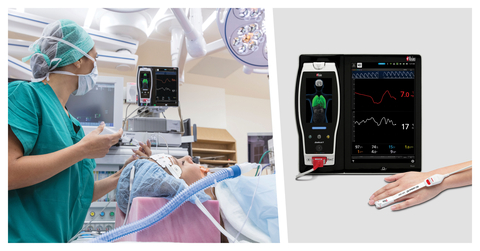New Study Evaluates the Use of Masimo PVi® As an Indicator of Fluid Responsiveness to Guide Goal-Directed Fluid Therapy in Elderly Patients Undergoing Gastrointestinal Surgery
Researchers Found That Fluid Therapy Guided by Noninvasive, Continuous PVi Reduced Cardiopulmonary Complications and Fluid Administered

Masimo Root® with PVi® and SpHb® (Photo: Business Wire)
Noting the particular value of optimizing fluid management during GI procedures, especially in elderly patients, because of the high rate of postoperative complications and frequent fluid deficits (because of preoperative fasting, bowel preparation, and intraoperative fluid loss), the researchers sought to determine whether GDFT using Masimo PVi might improve outcomes in this challenging scenario. PVi, or pleth variability index, is a measure of the variations in perfusion index over the respiratory cycle, and has the advantage, compared to arterial line-based methods of gauging fluid responsiveness (e.g. stroke volume variation [SVV] and pulse pressure variation [PPV]), of being obtained via noninvasive Masimo rainbow SET® pulse oximetry and Pulse CO-Oximetry. PVi is indicated as a noninvasive, dynamic indicator of fluid responsiveness in select populations of mechanically ventilated adult patients. As the researchers note, PVi has been shown to perform similarly to invasive methods of fluid assessment, such as PPV and SVV, in a variety of surgeries.2
The researchers enrolled patients aged ≥ 65 years scheduled for elective GI surgery at two university hospitals between November 2017 and December 2020. Patients were randomly assigned to the GDFT group (n = 107) or the conventional fluid therapy (CFT) group (n = 104). In the GDFT group, fluid therapy was guided by PVi obtained from the photoplethysmographic waveform measured by fingertip rainbow® Pulse CO-Oximetry sensors. The outcomes evaluated and compared between the two groups were: composite complications at 30 days after surgery; cardiopulmonary complications at 30 days (pneumonia, atelectatis, pulmonary edema, arrhythmia, and acute myocardial infarction); time to first flatus; postoperative nausea and vomiting; infections including anastomotic leak rates; and postoperative length of hospital stay.
The researchers found that the rate of cardiopulmonary complications, as well as the total volume of fluid administered intraoperatively, were statistically significantly lower in the GDFT (PVi) group, as highlighted in the table below. Although there was a trend toward shorter length of stay and lower anastomotic leakage rates in the PVi group, these and other outcomes were not statistically significantly different.
Outcome |
GDFT (PVi) group |
CFT group |
p-Value* |
|
Median volume of. fluids administered (ml) |
2075 (interquartile range: 1900, 2600) |
2500 (2000, 3100) |
0.008 |
|
Number (and percentage) of patients with one or more complications |
46 ( |
43 (41.3) |
0.089 |
|
…with cardiopulmonary complications |
9 ( |
20 (19.2) |
0.022 |
|
…with postop. nausea/vomiting |
42 ( |
35 (33.7) |
0.398 |
|
Median time to first flatus (hours) |
60 (interquartile range: 30, 93) |
52 (34, 81) |
0.475 |
|
Number (and percentage) of patients complicated by anastomotic leakage |
1 ( |
5 ( |
0.201 |
|
Median postop. length of stay (days) |
9 (interquartile range: 8,14) |
10 (8, 12) |
0.614 |
|
*A p-value < 0.05 was considered statistically significant. |
|
|
|
The researchers concluded, “Among elderly patients undergoing GI surgery, intraoperative GDFT based on the simple and noninvasive PVi did not reduce the occurrence of composite postoperative complications but was associated with a lower cardiopulmonary complication rate than usual fluid management.”
Joe Kiani, Founder and CEO of Masimo, said, “We introduced PVi in 2007. It was the first and is still the only way of measuring fluid responsiveness noninvasively via pulse oximetry, with our pulse oximeters, at a fraction of the cost of invasive methods and without risk of invasive procedures to the patient. Since then, PVi has made a tremendous contribution to patient care, and its utility as a fluid responsiveness indicator has been shown in more than 100 independent, published studies.2 This latest study adds to the outcomes evidence that PVi can be used to help clinicians manage the fluid levels of their patients without invasive catheters.”
In the
@Masimo | #Masimo
About Masimo
Masimo (NASDAQ: MASI) is a global medical technology company that develops and produces a wide array of industry-leading monitoring technologies, including innovative measurements, sensors, patient monitors, and automation and connectivity solutions. In addition, Masimo Consumer Audio is home to eight legendary audio brands, including Bowers & Wilkins, Denon, Marantz, and Polk Audio. Our mission is to improve life, improve patient outcomes, and reduce the cost of care. Masimo SET® Measure-through Motion and Low Perfusion™ pulse oximetry, introduced in 1995, has been shown in over 100 independent and objective studies to outperform other pulse oximetry technologies.3 Masimo SET® has also been shown to help clinicians reduce severe retinopathy of prematurity in neonates,4 improve CCHD screening in newborns5 and, when used for continuous monitoring with Masimo Patient SafetyNet™ in post-surgical wards, reduce rapid response team activations, ICU transfers, and costs.6-9 Masimo SET® is estimated to be used on more than 200 million patients in leading hospitals and other healthcare settings around the world,10 and is the primary pulse oximetry at 9 of the top 10 hospitals as ranked in the 2022-23
ORi and RPVi have not received FDA 510(k) clearance and are not available for sale in
References
- Wang Y, Zhang Y, Zheng J, Dong X, Wu C, Guo Z, Wu, X. Intraoperative pleth variability index-based fluid management therapy and gastrointestinal surgical outcomes in elderly patients: a randomized controlled trial. Periop. Med. 2023. 12:16. DOI: 10.1186/s13741-023-00308-0.
- Published clinical studies on PVi can be found on our website at http://www.masimo.com.
- Published clinical studies on pulse oximetry and the benefits of Masimo SET® can be found on our website at http://www.masimo.com. Comparative studies include independent and objective studies which are comprised of abstracts presented at scientific meetings and peer-reviewed journal articles.
- Castillo A et al. Prevention of Retinopathy of Prematurity in Preterm Infants through Changes in Clinical Practice and SpO2 Technology. Acta Paediatr. 2011 Feb;100(2):188-92.
- de-Wahl Granelli A et al. Impact of pulse oximetry screening on the detection of duct dependent congenital heart disease: a Swedish prospective screening study in 39,821 newborns. BMJ. 2009;Jan 8;338.
- Taenzer A et al. Impact of pulse oximetry surveillance on rescue events and intensive care unit transfers: a before-and-after concurrence study. Anesthesiology. 2010:112(2):282-287.
- Taenzer A et al. Postoperative Monitoring – The Dartmouth Experience. Anesthesia Patient Safety Foundation Newsletter. Spring-Summer 2012.
- McGrath S et al. Surveillance Monitoring Management for General Care Units: Strategy, Design, and Implementation. The Joint Commission Journal on Quality and Patient Safety. 2016 Jul;42(7):293-302.
- McGrath S et al. Inpatient Respiratory Arrest Associated With Sedative and Analgesic Medications: Impact of Continuous Monitoring on Patient Mortality and Severe Morbidity. J Patient Saf. 2020 14 Mar. DOI: 10.1097/PTS.0000000000000696.
- Estimate: Masimo data on file.
- http://health.usnews.com/health-care/best-hospitals/articles/best-hospitals-honor-roll-and-overview.
Forward-Looking Statements
This press release includes forward-looking statements as defined in Section 27A of the Securities Act of 1933 and Section 21E of the Securities Exchange Act of 1934, in connection with the Private Securities Litigation Reform Act of 1995. These forward-looking statements include, among others, statements regarding the potential effectiveness of Masimo PVi®. These forward-looking statements are based on current expectations about future events affecting us and are subject to risks and uncertainties, all of which are difficult to predict and many of which are beyond our control and could cause our actual results to differ materially and adversely from those expressed in our forward-looking statements as a result of various risk factors, including, but not limited to: risks related to our assumptions regarding the repeatability of clinical results; risks related to our belief that Masimo's unique noninvasive measurement technologies, including Masimo PVi, contribute to positive clinical outcomes and patient safety; risks that the researchers’ conclusions and findings may be inaccurate; risks related to our belief that Masimo noninvasive medical breakthroughs provide cost-effective solutions and unique advantages; risks related to COVID-19; as well as other factors discussed in the "Risk Factors" section of our most recent reports filed with the Securities and Exchange Commission ("SEC"), which may be obtained for free at the SEC's website at www.sec.gov. Although we believe that the expectations reflected in our forward-looking statements are reasonable, we do not know whether our expectations will prove correct. All forward-looking statements included in this press release are expressly qualified in their entirety by the foregoing cautionary statements. You are cautioned not to place undue reliance on these forward-looking statements, which speak only as of today's date. We do not undertake any obligation to update, amend or clarify these statements or the "Risk Factors" contained in our most recent reports filed with the SEC, whether as a result of new information, future events or otherwise, except as may be required under the applicable securities laws.
View source version on businesswire.com: https://www.businesswire.com/news/home/20230820369137/en/
Masimo
Evan Lamb
949-396-3376
elamb@masimo.com
Source: Masimo







